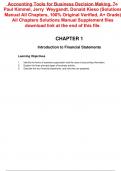Exam (elaborations)
Accounting Tools for Business Decision Making, 7e Paul Kimmel, Jerry Weygandt, Donald Kieso (Solutions Manual All Chapters, 100% Original Verified, A+ Grade) All Chapters
- Course
- Institution
Accounting Tools for Business Decision Making, 7e Paul Kimmel, Jerry Weygandt, Donald Kieso (Solutions Manual All Chapters, 100% Original Verified, A+ Grade) All Chapters CHAPTER 1 Introduction to Financial Statements
[Show more]



